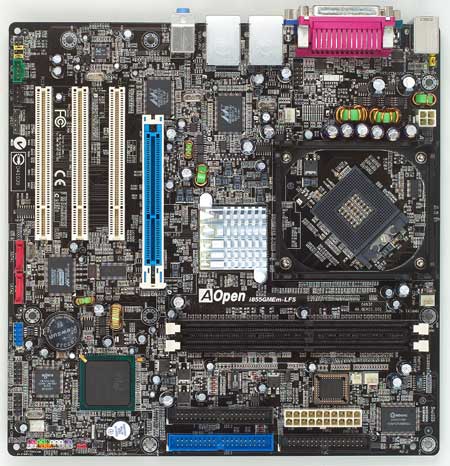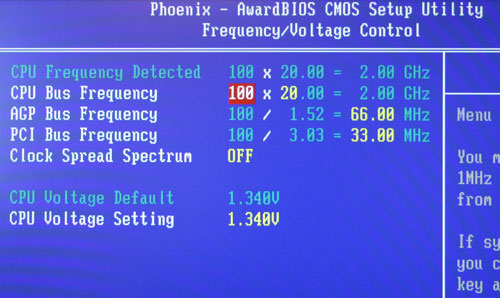Intel's Pentium M on the Desktop - A Viable Alternative?
by Anand Lal Shimpi on February 7, 2005 4:00 PM EST- Posted in
- CPUs
The Motherboards
As we mentioned before, both AOpen and DFI are currently shipping Pentium M desktop micro ATX motherboards based on Intel's 855GME chipset.AOpen
The AOpen GMEm-LFS is a micro ATX board based on the 855GME chipset, with integrated graphics support as provided by the chipset.
AOpen outfitted the board with dual GigE ports, both of which are placed on the back I/O panel above the four USB 2.0 ports.
The board only requires a 20-pin ATX power connector and a 4-pin +12V auxiliary connector like older Pentium 4 motherboards, although you can use a newer 24-pin PSU if you'd like.
Since AOpen uses ICH4-M, only parallel ATA is supported, so AOpen outfitted the board with a Promise SATA RAID controller to drive the two SATA ports on the board. AOpen also placed an Agere FireWire 400 controller on the board; however, they didn't supply the bracket to actually take advantage of the two ports supported by the controller.
The BIOS setup of the GMEm-LFS is pretty straightforward, although we definitely appreciated the layout of the overclocking options. The only complaint we had was that memory dividers weren't explicitly listed, which requires some math on the user's part to make sure that they're selecting the right memory speed when overclocking. The only voltage adjustments present on the board are for Vcore, which unfortunately tops out at 1.340V.

We had pretty decent overclocking success with the AOpen board and our Pentium M 755 (2.0GHz). Running it at 133MHz (533MHz FSB) x 18 at the maximum core voltage of 1.340V proved to be quite stable in all of our benchmarks. We could get the Pentium M to POST at 2.53GHz, but it wasn't stable enough to run our benchmarks.
Unfortunately, the biggest problem with overclocking the AOpen (as well as the DFI) board was that you could hardly overclock the memory bus. Regardless of what type of DDR400 memory we used, the highest that we could get the memory bus to run (stable) was 355MHz using the 4:3 memory divider.
Given how bandwidth-starved the Pentium M is, we were hoping for better overclocking success in the memory department, but were met with disappointment. The problem appears to be related to the 855GME chipset, as the DFI board suffered the same fate as the AOpen board.
So, while there's headroom in the CPUs (even our 1.7GHz Pentium Ms had no problems running above 2.0GHz), it seems like the chipsets/motherboards will limit the extent to which you can overclock.
The AOpen GMEm-LFS currently sells for $230.










77 Comments
View All Comments
bob661 - Tuesday, February 8, 2005 - link
The only problem with this chip is that the marketing is oriented towards the mobile market and therefore not a direct competitor to the A64. It would be nice if it was. It might bring some cats out of the bag on the AMD side. Competition in the marketplace is good for us all.jvrobert - Tuesday, February 8, 2005 - link
Really, AMDroids, get a grip. You're all excited because the AMD chips beat a mobile processor pretty handily, and because you are making some silly assumption that the Pentium-M in its current form is Intel's "last chance".First, Intel doesn't need a last chance. They make enough money to make AMD look like a Mexico City taco stand. So enough of those delusions of grandeur.
But on a technical front, if Intel ramps the clockspeed up to the 2.8 range (easy), and releases a desktop class chipset for the Pentium M it would match or exceed any current chip. And these are _basic_ steps. What if they made more improvements?
jvrobert - Tuesday, February 8, 2005 - link
bob661 - Tuesday, February 8, 2005 - link
#45You are a rock. The point of the article was to compare the P-M to desktop CPU's because most of us here wanted to know it will perform. And you know what? It performed very nicely.
classy - Tuesday, February 8, 2005 - link
I just can't help but to laugh at some folks. Its a nice chip but clearly not in the A64 ballpark. Its that simple. As far as the 2.8 oc, that was only accomplished in one reveiw. All the reviews show the same thing you have oc so it can it compete. What's interesting though is most of these Intel fanboys don't want to see a comparison of an oc'ed A64 vs a Dothan. Smoke city :)FrostAWOL - Tuesday, February 8, 2005 - link
IF the Pentium-M and P4 are electrically incompatible then someone please explain this:HP Blade system Pentium-M with Serverworks GC-SL chipset
http://h18000.www1.hp.com/products/servers/prolian...
FrostAWOL
jae63 - Tuesday, February 8, 2005 - link
Great review & of interest to those of us with HTPCs. Too bad the price point is so steep.One minor correction on page 11:
"The Pentium M does a bit better in the document creation tests, as they are mostly using applications that will fit within the CPU's cache. However, the introduction of a voice recognition program into the test stresses the Pentium M's floating point performance, which does hamper its abilities here."
Actually NaturallySpeaking uses almost no floating point but is very memory intensive. The performance hit that you are seeing is because it uses a lot of memory bandwidth and its dataset doesn't fit in the L2 cache.
Here's some support for my statement, by the main architect of NaturallySpeaking, Joel Gould:
http://tinyurl.com/6s4mh
segagenesis - Tuesday, February 8, 2005 - link
#43 - I think you have the right idea here. This processor is not meant to be performance busting but rather a low energy alternative to current heat factories present inside every P4 machine. I would love to have this in a HTPC machine myself but the cost is still too damn high. Hopefully higher production will bring the cost down.Aileur - Tuesday, February 8, 2005 - link
I guess the pentium M isnt ready (yet) for a full featured gaming machine, but with that kind of power, passively cooled, it would make for one hell of an htpc.PrinceGaz - Tuesday, February 8, 2005 - link
#45- It was not an unfair review, on the contrary it seemed very well done. The reason the P-M was compared with fast P4 and A64's is because they cost about the same.Maybe someone else buys your computers for you, but most of us here have to spend our own money on them so cost is the best way to decide what to compare it with.